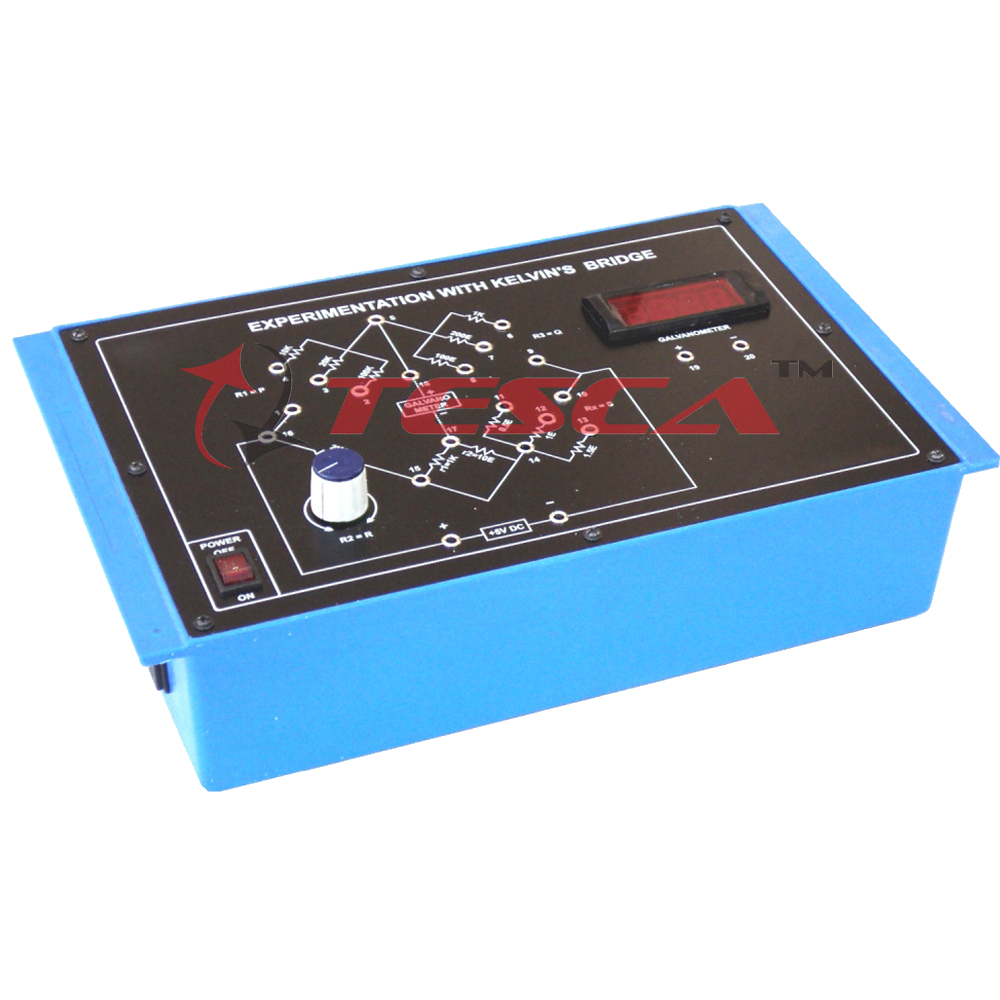Table of Contents
There are several tools and trainers helpful in putting the theories to the test. One such tool is Kelvin’s bridge experiment trainer. Kelvin’s bridge experiment trainer allows you to put this theory to the test. It comes with a primary bridge that you can use to learn about the concept of leverage and its many applications in our daily lives. It also has other accessories to help you understand Kelvin’s bridge experiment. Included are some weights, a ruler, and some other tools that will help you understand basic physics principles. Let us know more about this Trainer here:
Kelvin’s bridge experiment trainer: Uses, Components, Setup, Types & Price
What is Kelvin’s Bridge Experiment Trainer?
In physics, Kelvin’s bridge helps demonstrate a balanced system and some valuable theories. It is also helpful as an experiment to understand how waves behave in a two-dimensional space. The basic principle is to balance two arms of a Wheatstone bridge, one of which contains the unknown resistor in series with a known standard resistor. The other arm includes a variable resistor used to null the bridge. One can see the value of the unknown resistor read from a scale on the variable resistor.
A Kelvin’s bridge experiment trainer is a scientific instrument helpful in measuring the electrical resistivity of a material. It consists of two arms of known resistivity connected to a voltmeter and an ammeter. A material of unknown resistivity connects in series with one of the arms, and a current passes through the circuit. The voltage and current readings help calculate the resistivity of the material.
A Trainer is a valuable tool helpful in studying the principles of electrical circuits. It is named after Lord Kelvin, who first proposed using bridges to measure electrical resistance. The Trainer consists of interconnected electrical components, including resistors, capacitors, and an ammeter. Students can use the Trainer to create circuits and measure the circuit’s voltage, current, and resistance. It is a valuable tool for teaching the basic principles of electricity and circuits.
Uses of Kelvin’s Bridge Experiment Trainer?
Kelvin’s Bridge Experiment Trainer is beneficial for various purposes.:
- Kelvin’s bridge trainer measures the impedance of a material. The device consists of a bridge circuit with four arms, two of which are variable. It measures the impedance of a material by passing a current through the material and measuring the voltage drop across the material.
- It also measures the material’s capacitance by passing a current and measuring the voltage drop across the material.
- It measures the resistance of a material by passing a current through the material and measuring the voltage drop across the material.
- It is best in teaching the principles of electrical circuits and bridge circuits.
- In industry, it is helpful in testing and calibrating electrical equipment.
- In the workspace, it helps troubleshoot electrical problems.
Working Principle of Kelvin’s Bridge Experiment Trainer?
Kelvin’s Bridge experimental apparatus focuses on the electrical resistivity of a material. It consists of two arms of equal length, each with a variable resistor at one end. For experimenting on a material that one needs to test, one should place it in one arm, and a known resistor is placed in the other. A current passes through the material, and the voltage drop across the material is measured. The material’s resistivity can then be calculated from the measured voltage and current. The device consists of a bridge circuit with four resistors, a power source, and a meter. The resistors come in a Wheatstone bridge configuration. The power source connects to the resistors in the circuit so that a current can flow through the circuit. The meter is useful for measuring the voltage across the resistors. The principle of the experiment is- the voltage across the resistors helps to determine the value of the unknown resistor. It teaches the principles of Ohm’s law, Kirchhoff’s laws, and the Wheatstone bridge principle.
Components of Kelvin’s Bridge Experiment Trainer?
Kelvin’s bridge experiment Trainer consists of a bridge circuit with four arms, a power source, a meter, and a material to be tested. The power source supplies a current to the meter, which measures the voltage across the material one wants to test. One can place the material one wants to test in one of the arms of the bridge circuit. The other three arms of the bridge circuit contain resistors of known value. The bridge balances by adjusting the value of the resistors in the other three arms. The resistance of the material one wishes to test calculates from the known values of the resistors in the bridge circuit.
Kelvin’s Bridge Experiment Trainer Setup?
A Kelvin’s Bridge Experiment Trainer Setup typically includes a power supply, a bridge circuit, and Kelvin’s probe. The power supply provides the necessary power to operate the bridge circuit. The bridge circuit helps measure the resistance of Kelvin’s probe. Kelvin’s probe is useful for measuring the temperature of a conductor.
A Kelvin’s bridge experiment trainer setup is as follows:
1. Connect the AC power supply to the bridge mainframe.
2. Connect the bridge output terminals to the voltmeter.
3. Connect the unknown resistor to the appropriate terminals on the bridge.
4. Adjust the potentiometer until the voltmeter reads zero.
5. Repeat steps 2-4 for the known resistor.
6. Calculate the value of the unknown resistor using the known resistor value and the bridge equation.
Types of Kelvin’s Bridge Experiment Trainer?
There are different types of Kelvin’s bridge experiment trainers.
There are two types of Kelvin’s bridge trainers: the single bridge type and the double bridge type. The single bridge type helps to measure resistances up to 1 Kohm, while the double bridge type helps to measure resistances up to 20 Kohm.
- The single bridge type consists of a Wheatstone bridge with four arms. Two arms contain the unknown resistor and the standard resistor, while the other two contain the variable resistor and a fixed resistor. One can read the value of the unknown resistor from the scale on the variable resistor.
- The double bridge type consists of two Wheatstone bridges, each with four arms. One of the bridges is used to measure the unknown resistor, while the other measures the standard resistor. One can read the value of the unknown resistor from the scale on the variable resistor.
Both types of the bridge have a resistor connected in series with one of the arms. The resistor helps to create a voltage drop across the arm, which then helps to measure the arm’s resistance.
Kelvin’s Bridge Experiment Trainer Price?
Several factors affect the price of a Kelvin’s Bridge Experiment Trainer. The Trainer’s size and complexity, the components’ quality, and the brand name all play a role in determining the price. Generally, the larger and more complex the Trainer, the higher the price. The same is true for trainer models with higher-quality components. The brand name also plays a role in price, with more well-known brands commanding higher prices. On average, it costs between INR 4500 to INR 48000.
Tesca Global Kelvin’s Bridge Experiment Trainer?
Tesca Global is the leading provider of Kelvin’s Bridge Experiment Trainers. The product is a practical tool that provides the best education and workplace training tools available. With Tesca, customers are getting the best possible value for their investment.
Tesca’s Kelvin’s Bridge Experiment Trainer is the best education and workplace training tool. It helps users learn about the principles of electrical measurement. The Trainer comes with a comprehensive manual explaining the experiment’s theory and providing step-by-step instructions for experimenting. The Trainer has all the necessary equipment, including a voltmeter, ammeter, and bridge rectifier. Some of the specifications are:
- Tesca Global’s Kelvin’s Bridge Experiment Trainer has a built-in Kelvin’s Bridge circuit with arms values, unknown resistance 0.5W, 1.0W, 1.5W, known resistance R1 = 100KW, 20KW, 10K., R3 = 1K, 200E, 100E, DC power supply +5V, digital galvanometer, fuse, and light.
- And the best part? It operates on 230V ±10% at 50Hz A.C. Mains!
- The board has everything you need for a successful experiment, including a digital galvanometer, mains ON/OFF switch, and fuse.
- The high-quality terminals and sockets make it easy to connect and observe waveforms.
The Kelvin’s Bridge Experiment Trainer is the perfect tool for anyone who wants to learn about electrical measurement. It is an essential tool for any physics or engineering student. It is also a valuable resource for teachers who want to incorporate the latest physics experiments into their classrooms. If you’re looking for a comprehensive and reliable Kelvin’s Bridge experiment trainer, look no further than Tesca Global. Get yours from Tesca Global today!
Read also: Gas-Filled Diode ! TescaGlobal






Add comment